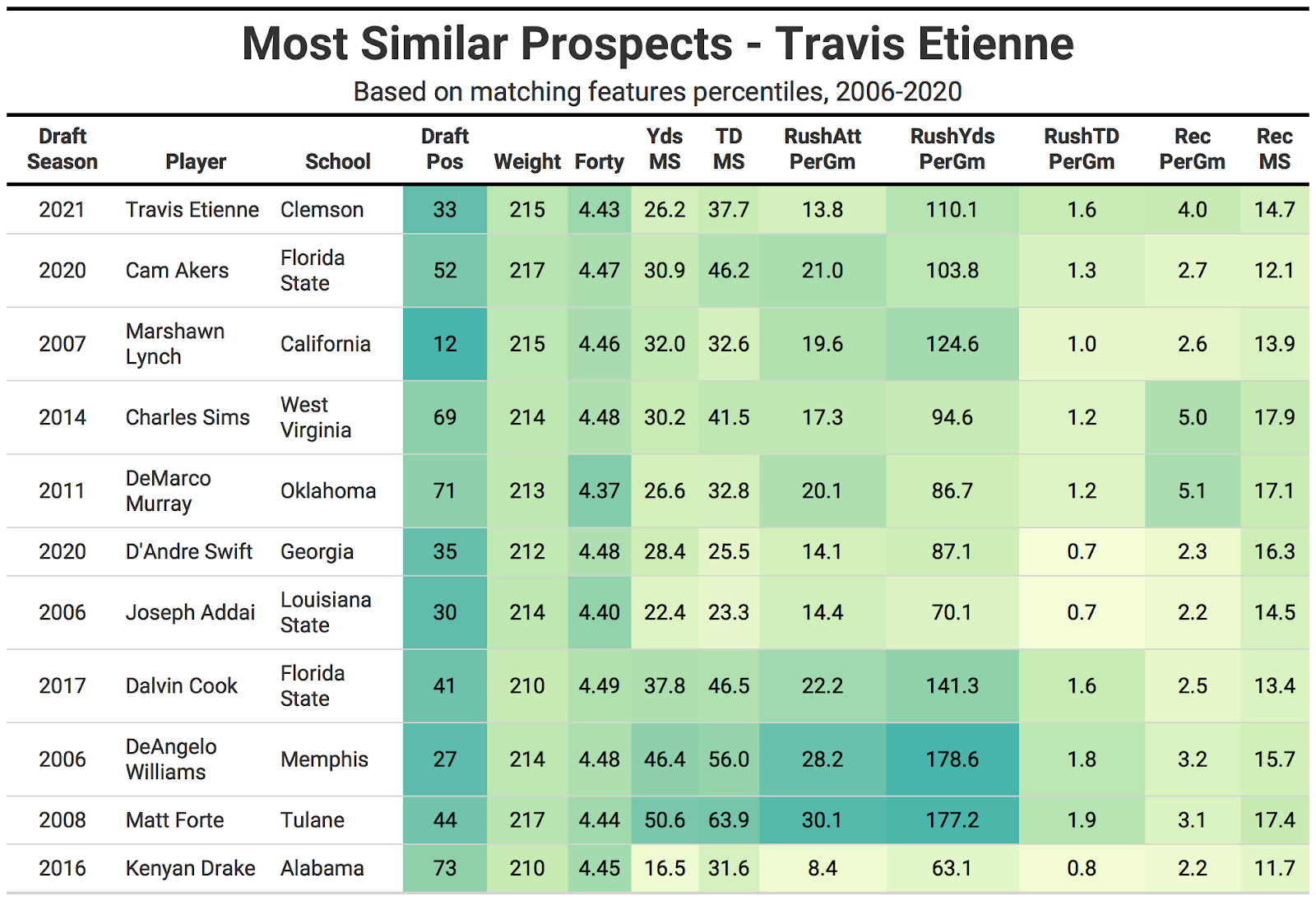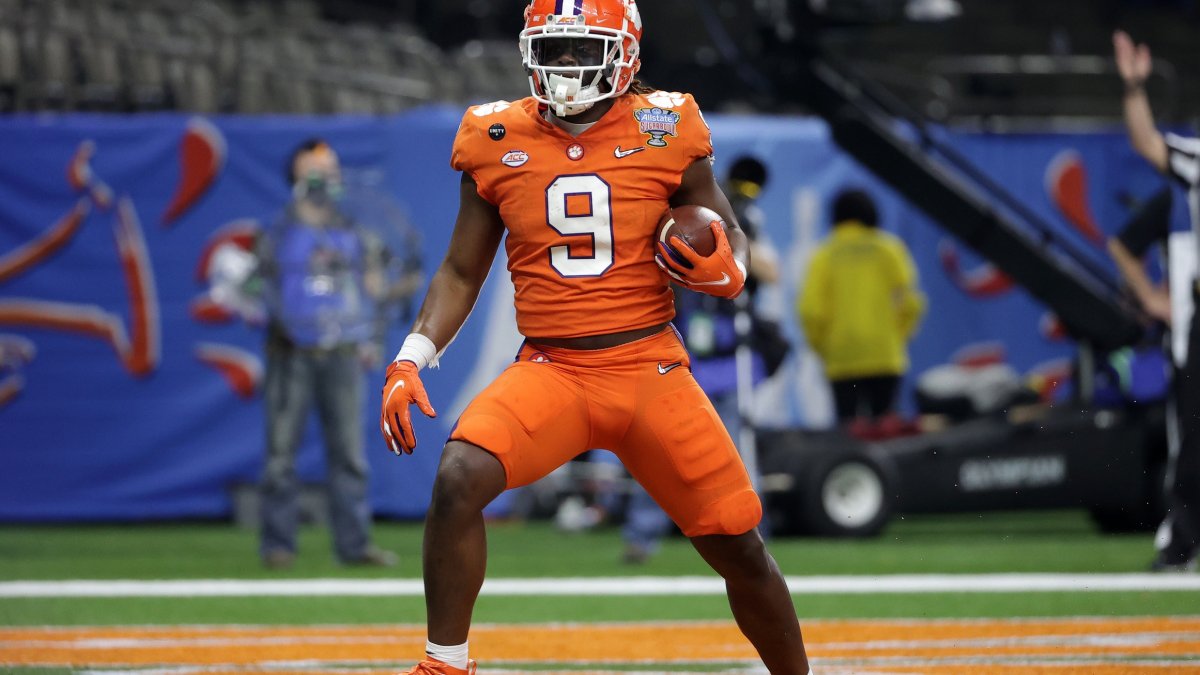Comparing current NFL draft prospects to those of years past is standard procedure in draft evaluation, though most comparisons are built on the memory recall and subjective opinion of the particular evaluator.
This will be the first in a series of articles comparing the 2021 draft prospects to prior years and picking out the most similar comps with a clearly delineated and quantifiable method.
PFF data scientist Eric Eager has done tremendous work building college-to-pro projections, which are built off the robust college data we’ve collected since 2014 and have been applied to exercises like building an “Analytics” Mock. In this analysis, I’m going to use some of our advanced stats for comparison but primarily rely on traditional stats to go back further to compare the 2021 prospects to draft classes going back to 2006.
Without the NFL Scouting Combine this season, the important measurables like weight and 40-yard dash will be reported through the various pro days that will be taking place over the next few weeks.
METHODOLOGY
The comps below were derived from a two-step process. First, I converted all the most statistically relevant stats and measurables to percentiles based on the thousands of prospects who have entered the NFL since 2006 at each position. Then, I filtered the total universe of past prospects by those who had draft positions, weight and 40 times within a 10th percentile in either direction of Travis Etienne.
The rest of the matching features were transformed by principal component analysis (PCA). I found the closest statistically comparable players by the euclidean distance between the players' principle components, listed in the top 10 below.
The metrics for PCA are: rushing attempts per game, rushing yards per game, rushing touchdowns per game, receptions per game and market share of team receptions. All of these data points come from the prospect’s best collegiate season. I also match the prospect’s market share of total team yards and touchdowns to past draft prospects.
For Etienne’s draft position, I’m using an estimate based on the mock data collected at GrindingTheMocks.com. For weight and 40 time, I’m using the numbers from Etienne’s Pro Day, with a 0.03-second penalty added to the forty time to reflect the uncertainty of pro-day timed measurements.
Most comparable players
Etienne wowed at his recent pro day, posting a larger-than-anticipated weight (215 pounds) with a blazing 40-yard dash time of 4.4 seconds. Adding those to his already strong collegiate stats gives him a solid group of similar prospects.

What jumps out about this group is receiving prowess, with all the running backs averaging over two receptions per game and accounting for more than 12% of their teams’ total receptions. They also are of similar weight, speed and draft capital.
Cam Akers is the closest comparable player, though there should be even more upside for Etienne if he’s taken much earlier in the draft. Akers is the dominant contender for the Rams’ lead running back spot entering his second season.
The names of other highly successful backs litter Etienne’s comps, including Marshawn Lynch, Joseph Addai and Dalvin Cook. Etienne’s comps have put up outstanding fantasy production through their first three NFL seasons in terms of weekly fantasy finishes.

Akers and D’Andre Swift are relatively light because they’ve only completed their rookie seasons. The rest of Etienne’s comps look amazing as a group, including Matt Forte, one of the strongest early-career fantasy producers.
Advanced Stats Comparison
Looking only at Etienne’s closest comparable players who played in the PFF College era (2014-2020), we can see how Etienne stacks up with his percentiles for rushing grade, receiving grade and other advanced stats like forced missed tackle rate and yards after contact. These stats are all from the prospects’ final seasons.

We added a couple of other names to this list that wouldn’t have made the top 10 going off the list above but would have been on an extended comparable player list.
Etienne is extremely well-rounded, according to our advanced stats, with a well-above-average rushing grade and a top-notch receiving grade. He also falls into the top quintile of performance with his ability to force missed tackles and generate yards after contact. There's a good reason why Etienne is the top running back on the PFF 2021 NFL Draft Big Board.
The Clemson back only had roughly average run blocking in his last season, which helps explain some of the drop in performance from his outstanding junior year.
Etienne profiles like historical backs who have been outstanding contributors from a real and fantasy football perspective. He is the kind of complete back that is needed to dominate in today’s NFL, and his pro-day size of 215 pounds gave his comps a tremendous boost without sacrificing his elite speed.



 © 2025 PFF - all rights reserved.
© 2025 PFF - all rights reserved.